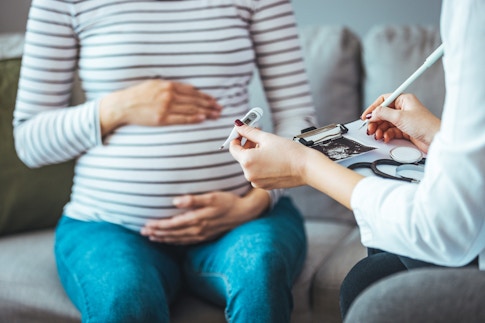
dragana991/iStock
A recent large-scale study (Che et al., Mol. Psychiatry, 2022) looked at how levels of immune system molecules in pregnant women and in their children at birth relate to later autism spectrum disorder (ASD) diagnosis. This research provides support for the idea that maternal immune changes, potentially relating to fever, infection, obesity, exacerbation of autoimmune diseases and/or other stressors in the mother during pregnancy are risk factors for the development of ASD; it also identifies potential biomarkers to aid early childhood diagnosis of the condition.
When we get a cold or virus, our immune system activates to protect us from the invading organism. Chemicals called cytokines and related immune molecules are released by the immune system to support this response. Work in animal models suggests that fetal exposure to altered immune molecules may cause changes in brain development (Deverman and Patterson, Neuron, 2009, Careaga et al., Biol. Psychiatry, 2017). Epidemiological studies in pregnant women have also shown that maternal fever is associated with an increased risk of ASD (Zerbo et al., J. Autism Dev. Discord., 2013, Brucato et al., Autism Res., 2017, Hornig et al., Mol. Psychiatry, 2018). Prior studies, however, had not followed women and their newborns across the course of pregnancy to compare how changing levels of immune molecules during pregnancy and at birth relate to later ASD diagnosis. Supported in part by a SFARI Simons Simplex Collection Award, SFARI Investigators W. Ian Lipkin and Mady Hornig and their collaborators leveraged blood samples and questionnaire data available from the Norwegian Autism Birth Cohort (Stoltenberg et al., Mol. Psychiatry, 2010) to address the link between maternal immune signatures and ASD risk.
The Autism Birth Cohort is part of a larger population-based pregnancy cohort — the Norwegian Mother, Father and Child Cohort Study (MoBa) — administered by the Norwegian Institute of Public Health between 1999–2009; it encompasses more than 95,000 mothers and 114,473 children (Magnus et al., Int. J. Epidemiol., 2006). Critically, women enrolled in this study had blood samples collected at around 18 weeks of pregnancy and at birth, and child umbilical cord blood was also collected at birth. Mothers participated in health and wellness questionnaires both during pregnancy and 6 months after giving birth, and provided questionnaire-based ASD screening information on their children at 18 months and then at 3, 5 and 7 years of age. This meant that Lipkin, Hornig and colleagues had access to biological samples both during pregnancy and at birth as well as detailed health metrics and clinical diagnoses.
Using the samples available from this large collection, Lipkin, Hornig and colleagues looked at levels of 60 different immune molecules in blood samples collected at mid-gestation from mothers and in cord blood samples collected from their children. In total, data was gathered from 457 children with ASD and 497 children without ASD. The concentrations of these 60 immune molecules were compared between children with and without ASD at both time points. Comparisons were done separately for specimens collected from male and female children, as boys are four times more likely to develop ASD and may have different risk factors for developing the condition than girls. The results showed a relationship between immune activation in the mothers and later ASD diagnoses in both boys and girls. In particular, the finding that immune molecule levels were higher in the mid-gestational samples compared to those in cord blood supports prior work suggesting that the increase in ASD risk is greater from maternal fevers that occur in the second trimester of pregnancy (Hornig et al. Mol. Psychiatry, 2018).
The research also found that girls with ASD diagnoses tended to have larger increases, and in a larger number of immune molecules, compared to boys with the condition. A study of autism recurrence patterns within families suggests that the greater risk in boys may reflect a potentially greater contribution from environmental factors versus genetic risk alone, as compared with girls, who may have higher genetic risk of developing the condition (Werling and Geschwind, Mol. Autism, 2015). Thus, the findings of the current study suggest that the immune system activation associated with ASD risk may differ in complex ways for boys and girls.
Importantly, the researchers also found that computer-learning programs could provide highly accurate predictions of which children did or did not have an ASD diagnosis when given data on immune profiles from either mid-gestational or cord blood samples. Higher levels of two immune molecules, called IL1RA and TNF-alpha, showed particularly strong relationships with later ASD diagnosis. Prominent increases were also found in VCAM-1 and SerpinE1, immune molecules that play a role in brain angiogenesis (a coordinated process that accompanies the prenatal development of brain structures), as well as in vascular inflammation. These data suggest that blood samples taken during early pregnancy or from cord blood may not only guide future studies of the mechanisms underlying ASD but could also potentially be of clinical use for very early diagnoses of increased ASD risk.
In conclusion, this study highlighted the importance of environmental factors in understanding ASD risk, by providing evidence that altered immune signatures, particularly in the early stages of pregnancy, may increase the risk of ASD in the child. It also demonstrated the need for large, well-characterized, longitudinal family cohorts in which participants can be followed over time to address questions about ASD diagnosis and symptom manifestations that may occur years after birth.
Reference(s)
Maternal mid-gestational and child cord blood immune signatures are strongly associated with offspring risk of ASD.
Che X., Hornig M., Bresnahan M., Stoltenberg C., Magnus P., Surén P., Mjaaland S., Reichborn-Kjennerud T., Susser E., Lipkin W. I.


